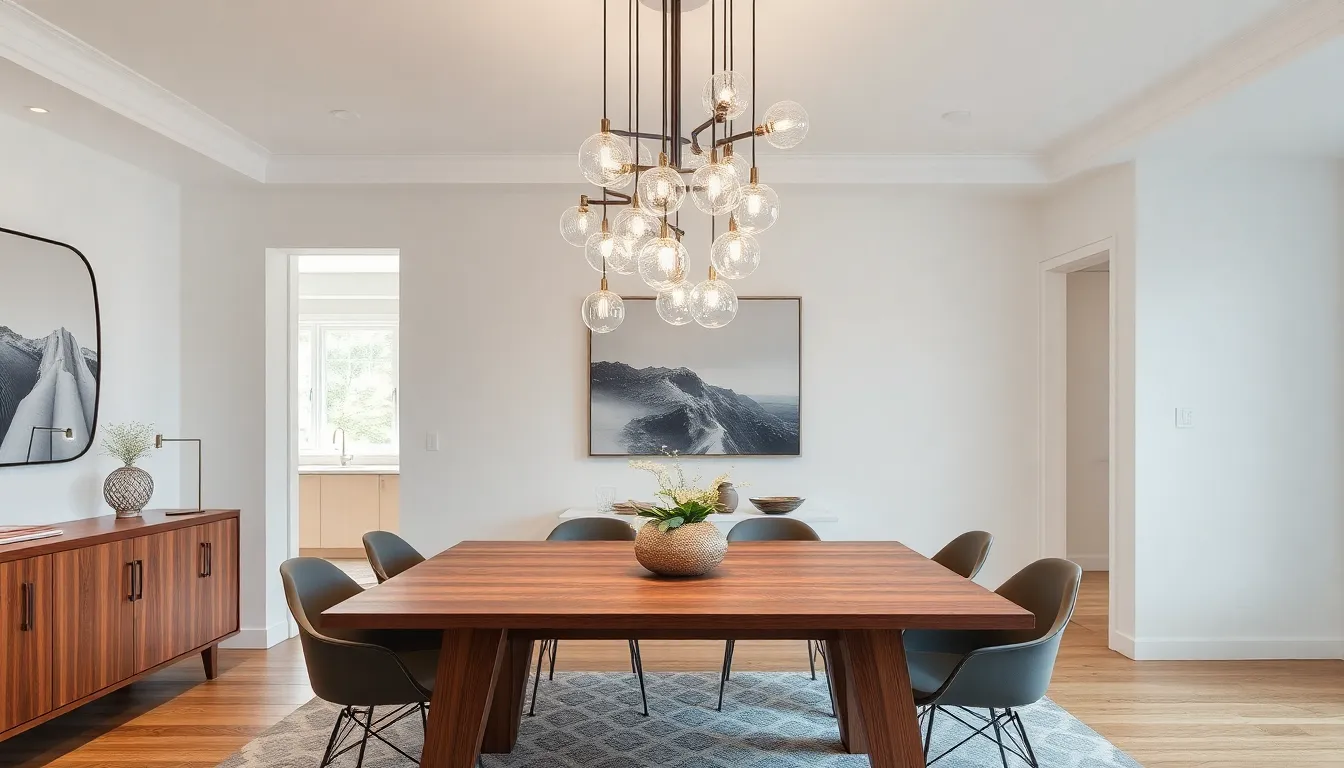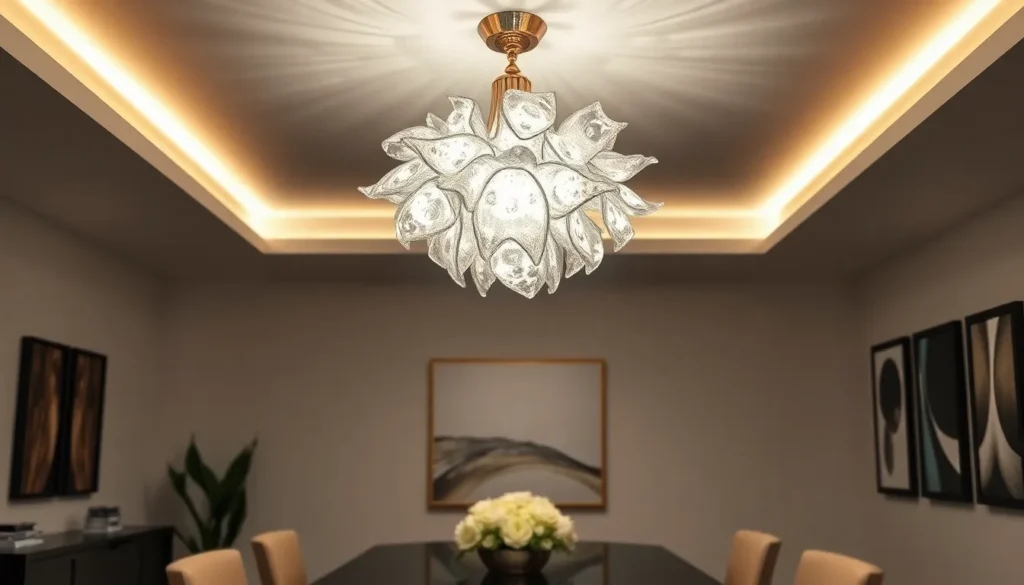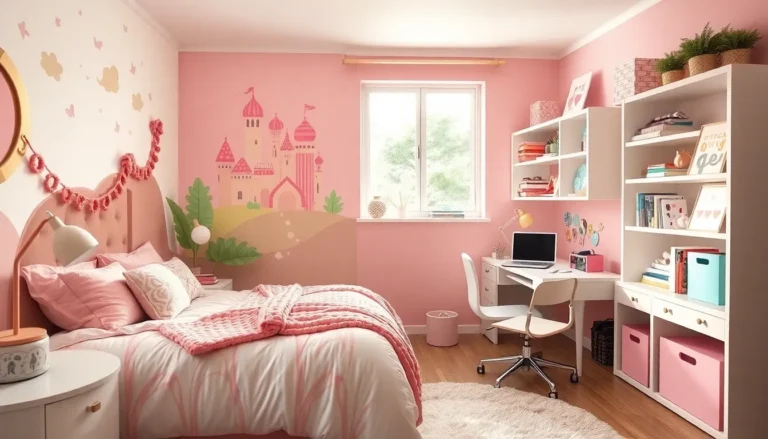Ceiling fixtures often go unnoticed, yet they hold the power to transform a space. Artistic ceiling fixtures do more than just illuminate; they serve as stunning focal points that elevate the overall aesthetic of any room. From intricate chandeliers to modern pendant lights, these pieces blend functionality with creativity, making them essential elements in interior design.
In today’s world, where personal expression is key, choosing the right ceiling fixture can reflect one’s unique style and taste. With a myriad of designs available, homeowners and designers alike can find the perfect match for their vision. As trends evolve, artistic ceiling fixtures continue to captivate with their ability to harmonize beauty and practicality, turning any ceiling into a canvas of light and art.
Table of Contents
ToggleOverview of Artistic Ceiling Fixtures
Artistic ceiling fixtures play a crucial role in enhancing interior design. These fixtures serve multiple functions, including providing light and acting as eye-catching elements. Common types of artistic ceiling fixtures include chandeliers, pendant lights, flush mounts, and ceiling fans.
Chandeliers feature intricate designs and often incorporate materials like crystal or glass. They create a dramatic effect in dining rooms, entryways, and living areas. Pendant lights, on the other hand, are versatile options suitable for spaces ranging from kitchens to cafes. They come in varying lengths and styles, offering flexibility in design.
Flush mount fixtures sit close to the ceiling, making them ideal for rooms with low ceilings. They combine functionality with artistic design, ensuring adequate light without overpowering the space. Ceiling fans, while primarily for airflow, also add a decorative touch. Available in various styles, they contribute to both comfort and aesthetics.
Homeowners seek artistic ceiling fixtures that resonate with their personal styles. Options range from modern minimalist designs to ornate vintage pieces. This diversity allows individuals to choose fixtures that reflect their tastes while maintaining the intended ambiance of each room. Decorating with these fixtures elevates the entire space, making ceilings a vital design element.
Types of Artistic Ceiling Fixtures


Artistic ceiling fixtures come in various styles and designs, each serving distinct purposes in interior spaces. The following sections provide detailed descriptions of popular types of artistic ceiling fixtures.
Pendant Fixtures
Pendant fixtures consist of a light source suspended from the ceiling, featuring a range of styles, sizes, and materials. They adapt easily to various environments, including kitchens, dining areas, and cafes.
- Single Pendants: Ideal for smaller spaces, these fixtures provide focused lighting.
- Multi-Pendant Arrangements: These create a striking visual effect, often utilized over dining tables or kitchen islands.
- Decorative Materials: Glass, metal, and fabric options enhance design flexibility and cater to different aesthetic tastes.
Chandelier Fixtures
Chandeliers stand out for their elaborate designs and dramatic presence. Commonly found in dining rooms and entryways, they elevate the ambiance of any space.
- Crystal Chandeliers: Renowned for their sparkling appearance, these fixtures captivate attention.
- Modern Chandeliers: Featuring sleek lines and minimalist designs, these blend well with contemporary decor.
- Vintage and Rustic Styles: These often incorporate wood or wrought iron, appealing to traditional and farmhouse aesthetics.
Flush Mount Fixtures
Flush mount fixtures attach directly to the ceiling, offering a streamlined look ideal for low-ceilinged rooms. They combine practical illumination with artistic flair.
- Standard Flush Mounts: These feature simple designs that provide essential lighting without overwhelming the decor.
- Decorative Flush Mounts: Unique patterns and artistic flourishes enhance visual interest while maintaining functionality.
- LED Options: Energy-efficient choices in this category contribute to sustainability and cost savings.
Design Considerations
When selecting artistic ceiling fixtures, several design considerations come into play to ensure they effectively enhance the overall aesthetic of a space. Key factors include style and aesthetics, size and scale, and light quality and functionality.
Style and Aesthetics
Style and aesthetics significantly influence the choice of ceiling fixtures. Designers can select from a spectrum of styles, including modern, traditional, industrial, and bohemian. Each style complements specific interior themes. For instance, a crystal chandelier introduces elegance, while a metal pendant light offers an industrial edge. Colors and finishes further enhance visual appeal, with options ranging from sleek metallics to warm wood tones. Selecting fixtures that align with the room’s decor creates a cohesive and inviting atmosphere.
Size and Scale
Size and scale play crucial roles in fixture selection. Homeowners should choose fixtures proportionate to the room’s dimensions. Oversized fixtures draw attention and serve as striking focal points in larger spaces. Smaller rooms benefit from more streamlined fixtures that avoid overwhelming the area. Additionally, ceiling height impacts choices—higher ceilings accommodate taller chandeliers or multi-pendant arrangements, while low ceilings favor flush mounts or slim pendants that maximize vertical space.
Light Quality and Functionality
Light quality and functionality remain essential considerations in artistic ceiling fixtures. Various fixtures provide different light outcomes, with some offering ambient lighting while others focus on task or accent lighting. Consideration of the fixture’s wattage and bulb type, such as LED, incandescent, or fluorescent, influences the warmth and intensity of light produced. Choosing fixtures equipped with dimmable features allows for adaptability in varying settings, enhancing the room’s versatility.
Popular Materials Used
Artistic ceiling fixtures utilize various materials that enhance their aesthetic and functional appeal. Understanding these materials helps in making informed decisions for interior design.
Metal and Glass
Metal and glass are prominent materials in artistic ceiling fixtures. Metal frames provide structural integrity and can be finished in diverse styles, including polished chrome, brushed nickel, and antique bronze. Glass elements, often used in shades or decorative insets, can range from clear to frosted, highlighting intricate designs. This combination creates striking contrasts and allows for an array of lighting effects. For example, a glass chandelier with a brass frame can complement modern or vintage spaces, enhancing overall ambiance.
Wood and Fabric
Wood and fabric offer warmth and texture in ceiling fixtures. Wooden designs often feature natural grains and can be stained or painted to match various decor styles. These fixtures provide an organic touch, suitable for rustic or eclectic interiors. Fabric elements, such as drum shades or textile wraps, enhance softness and diffusion of light. For example, a linen-covered pendant lamp adds a cozy atmosphere to dining areas, making it ideal for intimate gatherings.
Alternative Materials
Alternative materials are gaining traction in artistic ceiling fixtures, offering unique options. Materials like resin, bamboo, and recycled products reflect eco-friendly design choices. Resin allows for intricate shapes and colorful patterns, while bamboo provides a lightweight and sustainable option. Recycled metals or plastics promote sustainability without sacrificing style. For instance, a fixture made from reclaimed wood and glass can serve as a conversation piece while contributing to sustainable living practices.
Care and Maintenance
Caring for artistic ceiling fixtures involves regular cleaning, handling caution, and attention to electrical components. Cleaning helps maintain the shine and appearance of fixtures while ensuring optimal functionality.
Cleaning Techniques
- Dusting: Use a soft microfiber cloth to dust fixtures monthly. This removes surface dust and prevents buildup.
- Glass Cleaning: For glass elements, use a glass cleaner or a vinegar-water solution for streak-free results.
- Metal Care: Apply a gentle metal polish to restore shine, ensuring no abrasive products are used that may scratch surfaces.
- Fabric Components: Vacuum fabric shades using an upholstery attachment to avoid damaging fabric while removing dust.
Handling Caution
- Turn Off Power: Always switch off the power at the circuit breaker before cleaning or handling fixtures.
- Secure Positioning: Ensure ladders or stools used for access are stable to prevent falls. Ask for assistance when needed.
Electrical Safety
- Check Bulbs: Regularly inspect bulbs for signs of burnout or wear. Replace with the appropriate type and wattage as specified by the manufacturer.
- Wiring Inspection: Perform annual checks on wiring connections for fraying or looseness to prevent electrical hazards.
- Professional Help: Schedule an electrician for any repairs or upgrades to fixtures for added safety and compliance with electrical codes.
Environmental Considerations
- Protection from Moisture: Install fixtures in moisture-prone areas with appropriate models designed for humidity, such as those rated for bathrooms or outdoor use.
- Avoid Direct Sunlight: Positioning fixtures away from direct sunlight prevents fading and heat damage to materials over time.
Regular care and maintenance not only enhance the longevity and performance of artistic ceiling fixtures but also preserve their aesthetic appeal.
Artistic ceiling fixtures play a crucial role in defining the ambiance of a space. They offer a unique blend of style and functionality that elevates interiors while allowing personal expression. With a range of designs—from striking chandeliers to versatile pendant lights—homeowners can find the perfect pieces to reflect their tastes.
The right fixture not only illuminates but also transforms ceilings into captivating focal points. By considering design elements such as size, style, and material, individuals can enhance their environments significantly. Regular maintenance ensures these artistic pieces remain stunning and functional for years to come, making them a worthwhile investment in any home.



